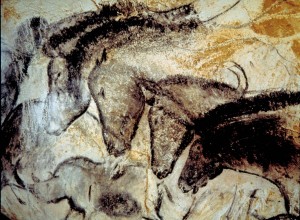Interactions between horse and man began as far back as 30,000 B.C., in which evidence is found in the crude cave paintings of the Paleolithic time period.  However, these paintings seemed to imply that horses were nothing more than meat, and that domestication may not have come onto the scene for another tens of thousands of years. After all, with the ages came the revelation that horses could be of much more use to man than merely as a meat source – especially since horses enabled the speed and stance to expound upon hunting practices. Theories suggest that domestication truly occurred around 2000 B.C.; yet, others suggest 4500 B.C. When the subject is analyzed from a mitochondrial DNA standpoint, the evidence would seem to imply that domestication occurred in more than one location, at more than one time. This in itself makes historical placement difficult.
However, these paintings seemed to imply that horses were nothing more than meat, and that domestication may not have come onto the scene for another tens of thousands of years. After all, with the ages came the revelation that horses could be of much more use to man than merely as a meat source – especially since horses enabled the speed and stance to expound upon hunting practices. Theories suggest that domestication truly occurred around 2000 B.C.; yet, others suggest 4500 B.C. When the subject is analyzed from a mitochondrial DNA standpoint, the evidence would seem to imply that domestication occurred in more than one location, at more than one time. This in itself makes historical placement difficult.
Yet, that is not the only aspect of equine domestication that is difficult to pinpoint. The first animal to be domesticated, as far as records can tell, is the dog; this process was estimated to have occurred 9 to 12,000 years ago. As time has proven, the dog is a highly integrated member of society – the bond is inextricable. But what about horses? At the absolute most, horses were used 9,000 years ago as well – though most theories would suggest only 4,000 years ago.  What exactly constitutes this time span? Prior to horses, man really only knew how to domesticate that which they understood – carnivores. Wolves and other pre-historic dogs were predators, seeking to track and kill – just as we were. But, horses are not predators. They are flight animals, having no aggressive tendencies, having no desire to hunt or kill or eat meat of any form! They did not seek out man and had no intention to do so. Our lack of understanding of herbivores, combined with the fact that these were the first animals domesticated for a purpose other than “fast food” led to a much more troublesome process. It is unclear how the first encounter with man and horse came about – at least where man was not trying to slay its find. Yet, now, like the dog, horses depend on us as we do them.
What exactly constitutes this time span? Prior to horses, man really only knew how to domesticate that which they understood – carnivores. Wolves and other pre-historic dogs were predators, seeking to track and kill – just as we were. But, horses are not predators. They are flight animals, having no aggressive tendencies, having no desire to hunt or kill or eat meat of any form! They did not seek out man and had no intention to do so. Our lack of understanding of herbivores, combined with the fact that these were the first animals domesticated for a purpose other than “fast food” led to a much more troublesome process. It is unclear how the first encounter with man and horse came about – at least where man was not trying to slay its find. Yet, now, like the dog, horses depend on us as we do them.
Horses held so much potential, but the question became, how do we join up with these majestic animals? How do we convince an animal that wants to run from us, that they can work with us? So, although it is unclear how this was done in the past, there are definable tactics today. Most notably, the domestication of horses is separated by the terms training and breaking. The methods are vastly different, but do have mutual key components:
- Safety – Horses are notably bigger, stronger, and faster than us – regardless of whether or not they know it. The goal is to keep both the horse and the humans safe throughout the process.
- Communication – Because of the safety issue, common ground must be established to give commands that will evoke the desired response. Confusing the horse will get you nowhere, so consistent directives must be given.
- Collaboration – If we want the animal to work with us, we must work with it. Working with horses must be mutual, for we cannot attempt to simply force a 1100 pound animal to do what we want.
However, training and breaking are definitely different approaches, leading to yet another hot controversy within the industry. 
